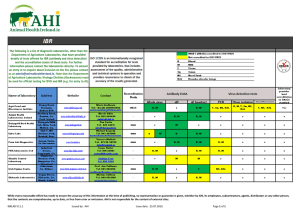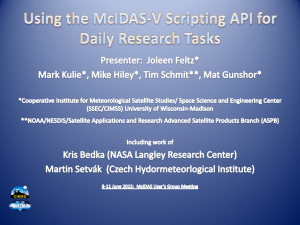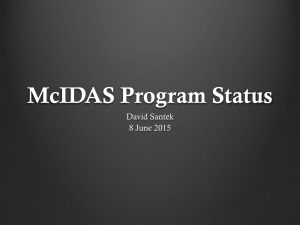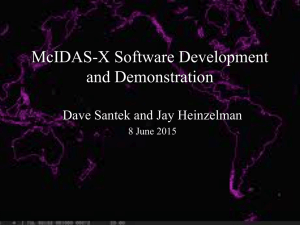Using McIDAS to perform validation and applications for Himawari and ABI
advertisement
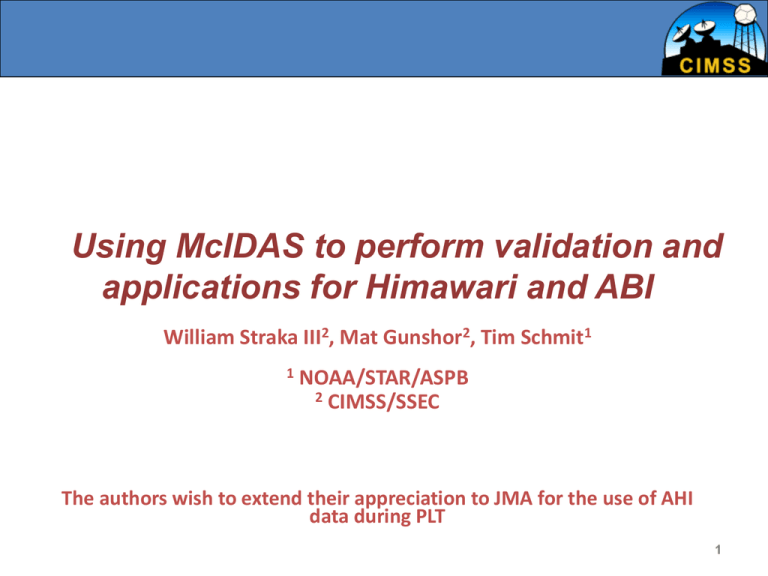
Using McIDAS to perform validation and applications for Himawari and ABI William Straka III2, Mat Gunshor2, Tim Schmit1 1 NOAA/STAR/ASPB 2 CIMSS/SSEC The authors wish to extend their appreciation to JMA for the use of AHI data during PLT 1 Overview • Introduction • AHI analysis and applications • ABI analysis and applications • Conclusions 2 Introduction • McIDAS-X and McIDAS-V have been used successfully to visualize output from AHI and ABI • Both have provided useful visualization to aid in cal/val activities for AHI • McIDAS-V has been used to visualized and provide feedback to Harris regarding output from the GOES-R Ground System 3 AHI 4 AHI • Both McIDAS-V and McIDAS-X can read in AHI data in a variety of formats – McIDAS-X • • • • ADDE server can be used to serve AHI HSF (raw data) directly to users Ability to display AHI HSF to McIDAS-X clients Ability to download (IMGCOPY) AHI data to local AREA files Fast track is currently in testing – McIDAS-V • Can display AHI data from – – – – McIDAS-X ADDE server JMA netCDF files netCDF4 output from libHimawari output Algorithm output from various processing frameworks • Utilizing various plugins, provides the ability to create combination products. • Allows for overlaying of output from various processing frameworks for quick analysis 5 AHI • CIMSS scientists currently working with the McIDAS User Group in the development of McIDAS ADDE server to ensure scientific accuracy of the data shown in McIDAS • The ability to read in the AHI data using McIDAS-X and McIDAS-V provides the ability for quick and easy comparisons for scientists 6 AHI • Both AHI PLT and publically released data has been used to perform many different validation and applications – Validation • Ability to visually show artifacts in data, which are then passed to the CWG and JMA for analysis • Demonstration of Stray-light and other features for users • INR comparison – Applications • RGB composites (ex. Dust/airmass) • Side-by-side channel display • Overlay different channels/satellites 7 MTSAT and AHI (visible) McIDAS-V 8 Approximate spatial resolution: 1 km Approximate spatial resolution: 0.5 km INR observations 25 Jan 2015, 0230Z 0.86mm, Band 4 4.7km 9 INR observations 25 Jan 2015, 0230Z 11.2mm, Band 14 ~0km 10 23 Mar 2015, 15:20 UTC AHI Band 7 (3.9um) Stray light artifact analysis - B06 Product applications - Fires Product Applications – Dust RGB Product Applications – Vol Ash RGB ABI 16 ABI • McIDAS-V has the ability to read in CFcompliant netCDF4 files • McIDAS-V can currently navigate and display GOES-R ground system (GS) files • Allows for quick analysis and identification of potential issues from GS output 17 Band 14 (11.2 mm) LST Mode 3 – Full Disk Galveston Bay GOES-R GS Output ABI McIDAS-V Issues • Issues with Mc-V – Due to the large file sizes of ABI, only 1 channel of Full Disk Bands 1,3,5 (1km) can be read in per session at full resolution along with long load times – The Full Disk of Band 2 (0.5km) cannot be read in at native resolution with 20GB of RAM – Both issues could be mitigated by striding the data, when this becomes available • Not currently working in McV 1.5, but inquiry submitted • However this means that the visual quality of the data is reduced – Another possibility is using an ADDE server to read in high resolution data • Example: Band 3 of AHI, which is also a 0.5km resolution image, can be read in with McIDAS-V 1.5 with no issues via the 2015.1 ADDE server. 21 CONCLUSIONS 22 Conclusions • McIDAS-X and McIDAS-V are currently being used by CIMSS and other scientists for analysis and product applications for AHI • McIDAS-V is being used at CIMSS and other places for analysis of output from the GOES-R Ground System (GS) – McIDAS-V is ready on “day one” to read in output from the GS – Some issues remain, such as striding the output, which will be resolved soon • Anticipating the GOES-R ABI McIDAS-X ADDE server 23
